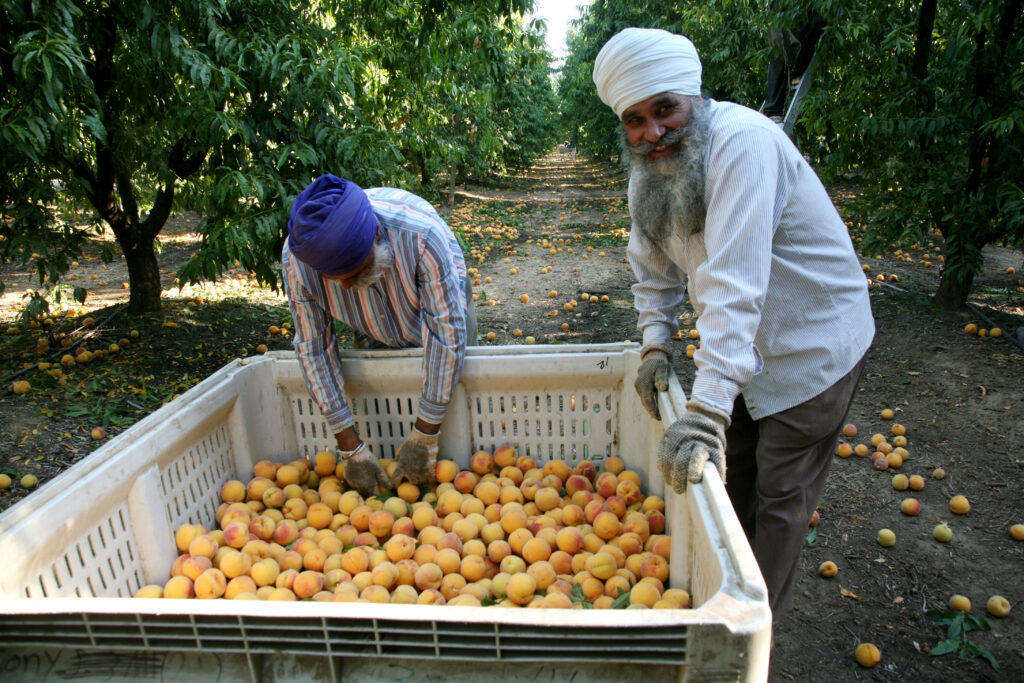Agricultural workers are visited by pop-up vaccination clinics throughout California, including this one in Fresno, as part of a focused effort to vaccinate with equity. The agricultural workforce is largely made up of immigrant workers, a population that is disproportionately impacted by COVID-19. Getting vaccinated will protect workers, families and communities by slowing the spread and ultimately ending the pandemic. Photo By Bryan Patrick, February 2021
Also available in Chinese, Vietnamese, and Korean.
Workers and community members can sign up to be alerted through ‘My Turn’
(February 2021) — Efforts to ramp up California’s vaccinations are taking to the fields and packinghouses where much of the state, nation and world’s food is grown, harvested, and packed largely by Latino and immigrant workers who are disproportionately impacted by COVID-19.
As part of Gov. Gavin Newsom’s goal to equitably accelerate vaccine distribution, farmworkers have been prioritized to receive the protective inoculations. Although vaccine supply still is limited in California, several pop-up vaccination sites have begun in Central Valley and Southern California fields and agricultural operations to get vaccines to some of the hardest-to-reach and historically underserved populations.
From Fresno’s agricultural fields and rice paddies in Sacramento, to almond and walnut farms in Yuba City and meat-packing houses in Coachella, farmworkers rolled up their sleeves and began receiving the COVID-19 vaccine to protect them, their families, and their communities from the deadly virus.
California’s agricultural laborers are the most diverse population of farm workers in the nation. Immigrants from China, Japan, India, Hawaii, and the Philippines were among the first to till the state’s fertile soils, with more coming from Korea, India, Laos and Vietnam in the latter half of the 20th century. Filipino farmworkers joined hands with Cesar Chavez and Dolores Huerta in the 1960s to form the United Farm Workers.

Over 93 percent of farmworkers today are from Latin America, but the Department of Labor reports that about 1 percent — roughly 8,000 workers — are migrants from Asian countries. Notably, about 1300 refugee Hmong, Mien, and Lao farm families have been working in Fresno since 1976.
Immigrants from Asia represent a significant percent of the workforce at meat-packing plants and slaughterhouses, according to data from the Economic Policy Institute: almost 6 percent are from India, 4.6 percent from the Philippines, 4 percent from China, and 5.2 percent from Burma.
The state’s new vaccine eligibility standard took effect in February so that food and agriculture workers, individuals 65 and over, and workers in education, childcare and emergency services can receive vaccines as additional supply arrives in California. The state will track and analyze who is getting the vaccines to ensure equitable distribution among California’s extremely diverse populations. The information collected will be protected and remain private.
Getting a COVID-19 vaccine is free for everyone. Californians who lack insurance can get the vaccine at no cost, as can those who are undocumented. The vaccine is being distributed regardless of insurance and immigration status, which will not be asked. COVID-19 testing and treatment alone, including vaccinations, do not count under the public charge rule.
Doctors and research scientists cite the success of vaccine trials in assuring that the current COVID-19 vaccine is safe and highly effective. Ethnically inclusive testing of the vaccine showed positive results for all ethnicities and races.

COVID-19 has impacted Latinos at a disproportionate rate, making up 55 percent of cases in California and 46 percent of COVID-19 deaths. The higher infection rate and mortality rates in the Latino community have devastated families across the state. Getting vaccinated and following safety precautions will protect communities by slowing the spread and ultimately ending the pandemic.
A new website, MyTurn.ca.gov, is available statewide to help Californians sign up to be notified when they are eligible to make an appointment to be vaccinated. MyTurn.ca.gov also will keep track of who needs to receive their second dose and provide notifications. The website is available in English and in Spanish with additional languages coming online by the end of the month.
Those without access to the internet can call the COVID-19 Hotline at 1-833-422-4255 (833-4CA-4ALL), which includes a language support center to assist with MyTurn.ca.gov sign up. All personal information is confidential and protected. More information and resources are available at www.VacinateAll58.com.
Together, we can help all communities stay safe and end the pandemic.




